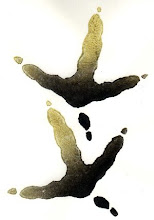Sunday afternoon, temperature finally in the double digits.
Let's take the dog out to celebrate.
A spot known to famous grousers, with the suffix "Hollow".
Working through a thick stand of pines, low alders to my right.
Conley gets birdy in the thickest of the thick. Snow covered brushpiles.
Wirrrrrrr...sound of a grouse flushing. Close, and sounding like it did not fly far.
Looking for it in a tree. Nope.
Dog returning to me with live bird in his mouth.
Hmmmm....good boy. I think so, anyway. What's a fella to do?
Subscribe to:
Post Comments (Atom)









3 comments:
. . . "what with your ethics."
;-)
sorry, had to say it. Good job, Conley. Maybe that's one you crippled last fall Rico. That or Andy's breeding them stupid now, like those ultra-tame Maine birds.
or maybe it's mercury-poisoned--I hear ducks exude toxins with every breath, so that bird may just have gotten too close to a duck. NYDEC doesn't specify a definite distance to a duck per dose, but it's safest to avoid counties where ducks reside. Your grouse learned that lesson the hard way.
Rich,
Give ole' White Buff an atta boy for me... saving ammo in a down economy is almost as good as Victory Gardening.
Jim, is an amazingly prescient scientist. Always at the cutting edge of discovery and scholarly dissemination, and ahead of the rest of us, as usual.
For example, I was just about to report on the mercury in grouse thing, but, once again, in his clinical and feeling-less way, he beat me to the punch. Where's the love?
Alas, again for the rest of us,please refer to Figure 45.2 on page 338 of the Field Manual of Wildlife Diseases: Birds. Here you will find a listing of representative groups of avian species most likely to be exposed to mercury. Yep, you guessed it, the Gallinaceous bird group is there. Grouse are specifically called out.
Quoting, and in reference to Jim's lightening quick assessment and brilliant supposition regarding duck breath: "Clinical signs of mercury poisoning in birds have been documented...and they include incoordination, tremors, weakness, ruffled feathers, and drooping eyelids. Experimental exposure of birds to high levels of mercury has caused acute death in less than 1
hour with few signs of intoxication. In free-ranging birds, most cases of mercury poisoning are probably more insidious, resulting in an emaciation syndrome and a variety of sublethal effects that may act together to cause eventual death."
see http://www.nwhc.usgs.gov/publications/field_manual/chapter_45.pdf
Scooped again by JT. From the evidence presented, its pretty clear that your bird, Rich, suffered from mercury duck breath proximity. Obviously.
great find Cagey. the gov't document provides confirmation of the mechanism:
"Avoid exposure to . . . mercury, which is volatile and can be inhaled in significant amounts in [ducky] areas" (p 340).
I paraphrase and misquote promiscuously.
Post a Comment